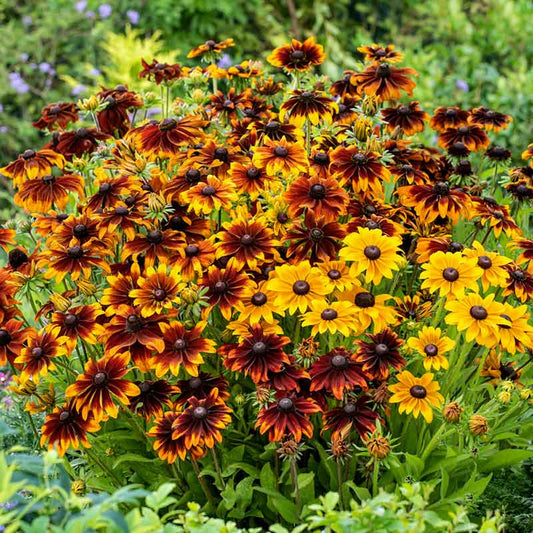-
main-collection-product-grid

Black Eyed Susan Seeds
This distinctive wildflower is a North American native and great for a kid's gardenBlack Eyed Susan Seeds
This distinctive wildflower is a North American native and great for a kid's gardenRegular price As Low As $4.99Regular priceUnit price per -
main-collection-product-grid

Black Eyed Susan Seeds - Vine Mix
A vigorous free-flowering vine that can reach eight feet in a seasonBlack Eyed Susan Seeds - Vine Mix
A vigorous free-flowering vine that can reach eight feet in a seasonRegular price As Low As $4.99Regular priceUnit price per -
main-collection-product-grid

Black Eyed Susan Seeds - Double Golden Gloriosa
Low-maintenance perennial reliably produces huge double bloomsBlack Eyed Susan Seeds - Double Golden Gloriosa
Low-maintenance perennial reliably produces huge double bloomsRegular price As Low As $5.99Regular priceUnit price per -
main-collection-product-grid

Black Eyed Susan Seeds - Goldilocks
Not too small, not too large—this mix is just rightBlack Eyed Susan Seeds - Goldilocks
Not too small, not too large—this mix is just rightRegular price As Low As $6.99Regular priceUnit price per -
main-collection-product-grid

Black Eyed Susan Seeds - Gloriosa Daisy Mix
We think these golden blooms are divineBlack Eyed Susan Seeds - Gloriosa Daisy Mix
We think these golden blooms are divineRegular price As Low As $4.99Regular priceUnit price per -
main-collection-product-grid

Black Eyed Susan Seeds - Marmalade
You'll want to save these colorful petals for crafts and arrangementsBlack Eyed Susan Seeds - Marmalade
You'll want to save these colorful petals for crafts and arrangementsRegular price As Low As $4.99Regular priceUnit price per -
main-collection-product-grid

Black Eyed Susan Seeds (Dwarf) - Rustic Mix
Compact plants boast vibrant full-size bloomsBlack Eyed Susan Seeds (Dwarf) - Rustic Mix
Compact plants boast vibrant full-size bloomsRegular price As Low As $4.99Regular priceUnit price per -
main-collection-product-grid

Black Eyed Susan Seeds - Green Eyes
Also called Irish Eyes, this unique heirloom variety has striking green centersBlack Eyed Susan Seeds - Green Eyes
Also called Irish Eyes, this unique heirloom variety has striking green centersRegular price As Low As $6.99Regular priceUnit price per -
main-collection-product-grid

Black Eyed Susan Seeds - Autumn Forest
Prolific bicolored blooms are perfect for fall bouquetsBlack Eyed Susan Seeds - Autumn Forest
Prolific bicolored blooms are perfect for fall bouquetsRegular price As Low As $4.99Regular priceUnit price per
Growing heirloom Black Eyed Susans in your garden
- 9 heirloom Black Eyed Susan seed varieties
- Easy to grow and maintain
- Pollinator attractor
- Thrives in full or partial sun conditions
Add the Best Heirloom Black Eyed Susans to your Garden
The heirloom Black Eyed Susan is a mainstay of any wildflower meadow and is possibly the most iconic of the classic North American wildflowers. These blossoms are often referred to as "pioneer plants" since they are the first to emerge after a fire or natural calamity. This aster-family herbaceous plant is native to the eastern and central United States, but it has become naturalized throughout North America.
Growing conditions for heirloom black eyed susan seeds
Heirloom Black Eyed Susans, also known by their formal name Rudbeckia hirta, can be grown in a variety of soils, ranging from sand to clay, as long as the soil temperature is about 70°F. These blossoms are exceptionally hardy and will thrive whether you start them indoors or seed them directly into your flower garden! Despite their ability to thrive in relatively dry soil, heirloom Black Eyed Susans benefit from periodic watering in dry weather and plenty of sunlight. They also enjoy being planted with a variety of other flowers, such as zinnias and Gerber daisies.
How to care for heirloom black eyed susans
Heirloom Black Eyed Susans are tall plants with upright branches and ovate-shaped leaves that grow between 12 and 27 inches tall. To avoid crowding, these fast-growing heirlooms should be planted six to eight inches apart. Depending on your zone and when the seeds are planted, heirloom Black Eyed Susans can bloom in the spring, summer, or fall. It's crucial to remember that these plants mature 60 to 90 days after sowing and prefer to be planted in the spring or fall.
Blooms may not occur in the first year of growth; instead, they usually arrive in the second year. When these new blooms do appear, expect to be met by pollinators like bees and hummingbirds, who will be delighted to see these lovely, daisy-like blossoms! Heirloom Black Eyed Susans are deer resistant, drought resistant, and poor soil tolerant, in addition to being pollinator magnets. To summarize, these flowers are really simple to cultivate and manage, and they make a beautiful, low-maintenance addition to any garden! Additionally, if you want to use your blossoms in a cut flower arrangement, heirloom Black Eyed Susans have a six to ten day vase life and look great with just about any other cut flowers!
Heirloom Black eyed susans in packets or bulk
A packet of Eden Brothers' Heirloom Black Eyed Susans may suffice if planted in a modest area (80 square feet or less). However, this variety is available in packages weighing up to five pounds and covering up to 1.3 acres of ground!
For more information about planting, growing, and caring for heirloom Black Eyed Susan flower seeds, see the Black Eyed Susan Seeds Planting Guide.








